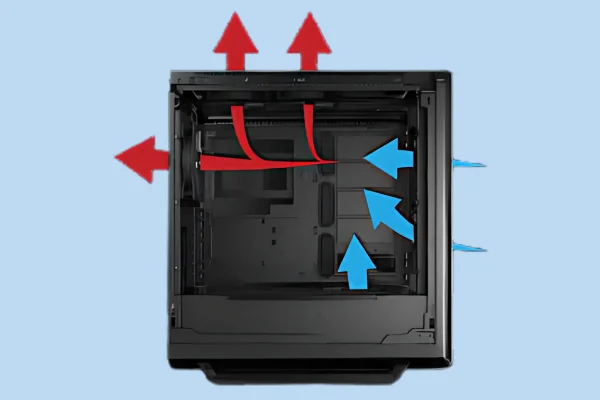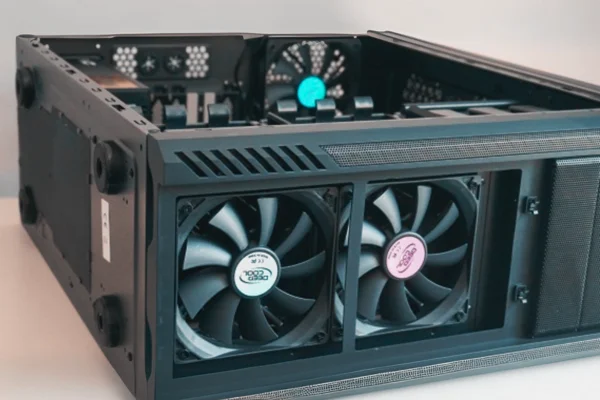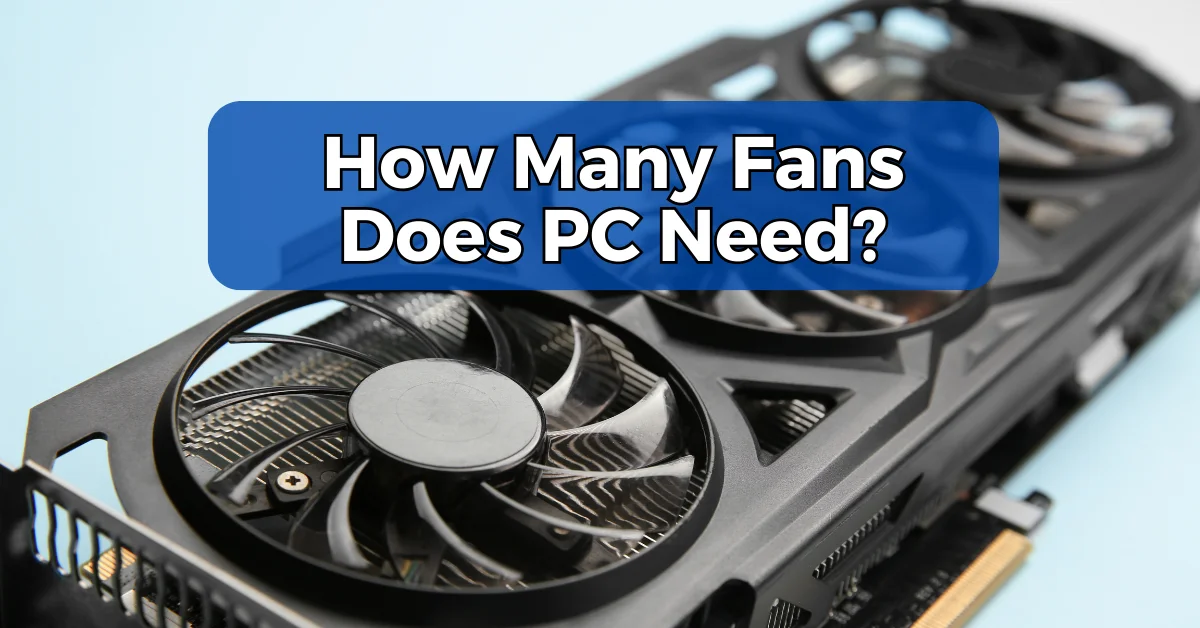Overheating can permanently damage PC components like the CPU, GPU, and hard drives. Most off-the-shelf PCs can only operate up to 150°F (70°C) before damage occurs.
So how many fans does a PC need? A PC needs 2 fans (1 intake, 1 exhaust) is sufficient for normal usage and low-end gaming PCs.
Gaming PCs with high-end components and heavy usage require more cooling. Most gaming rigs benefit from 3-5 well-placed fans to keep temperatures in check and prevent overheating damage.
But don’t stop reading just yet. Keep on reading to learn all about fans requirements.
What Do Case Fans Do?

Case fans are essential for managing the temperature inside a PC by controlling airflow. They typically come in two types: intake and exhaust. Intake fans draw cool air from outside the case, while exhaust fans expel hot air generated by internal components. This continuous flow of air helps dissipate the heat produced by the CPU, GPU, and other parts, preventing the system from overheating.
Balanced airflow is crucial for maintaining optimal internal temperatures. If a system lacks proper airflow, hot air can accumulate, leading to performance issues like thermal throttling, where components slow down to avoid damage. By ensuring a steady circulation of cool and hot air, case fans help maintain stable temperatures, prolonging the life of your hardware and ensuring efficient performance.
How Many Fans Does a PC Need by Case Size?
The number of fans your PC needs depends largely on the size of the PC case and its airflow design.
| Case Size | Minimum Fans | Recommended Fans |
|---|---|---|
| Small Form Factor | 1-2 | 2-3 |
| Mid-Tower ATX | 2-4 | 4-5 |
| Full-Tower ATX | 4-5 | 5-6 |
| High-Performance or Overclocked Builds | 4-5 | 6+ fans or liquid cooling |
Small Form Factor (SFF) Cases: Due to limited space, these cases often require minimal cooling, typically 1 to 2 fans. A single exhaust fan is common, though adding an intake fan can improve airflow.
Mid-Tower Cases: These are the most common and usually come with 2 to 4 fan mounts. A balanced setup with 2 intake fans at the front and 1 or 2 exhaust fans at the back or top is ideal for maintaining proper airflow.
Full-Tower Cases: Larger cases provide more fan mounting options, often supporting 5 or more fans. For high-performance or gaming builds, a combination of 3 intake and 2 exhaust fans offers optimal cooling, especially if you’re running powerful components or overclocking.
Larger cases typically benefit from more fans due to increased internal space, which can trap heat if not properly ventilated.
Types of Fans in a PC

A well-designed PC typically includes several types of fans to ensure comprehensive cooling. Each fan serves a specific purpose and contributes to the overall thermal management of the system.
Case Fans
Case fans are responsible for maintaining airflow inside the PC case. They come in various sizes, typically ranging from 80mm to 200mm, with 120mm and 140mm being the most common.
Case fans can be configured as either intake fans, drawing cool air into the case, or exhaust fans, pushing hot air out. The optimal configuration depends on the case design and the desired airflow pattern.
CPU Fans
The CPU is one of the hottest components in a PC, generating significant heat during operation. They work with heatsinks or liquid cooling systems to dissipate the intense heat produced during heavy processing tasks.
Aftermarket CPU coolers often include larger fans or even multiple fans for enhanced cooling performance.
GPU Fans
GPUs have built-in fans to cool the graphics card during intense gaming or rendering. In some setups, additional case fans may be needed to support the GPU’s cooling needs, especially in high-performance systems.
Power Supply (PSU) Fans
Power supplies generate heat as they convert AC power to DC power for the PC components. Most modern power supplies include a fan to cool the internal components and maintain stable operation. These fans operate quietly and ensure the PSU doesn’t overheat, which could lead to system failure.
Additional Fans (e.g., RAM or storage fans)
In some cases, enthusiasts may choose to install additional fans for specific components like RAM modules or storage drives. While not always necessary, these fans can provide extra cooling for overclocked or heavily utilized components.
However, their effectiveness depends on the specific cooling requirements of the components and the overall airflow within the case.
Factors That Determine How Many Fans You Need
When determining how many fans your PC requires, several factors come into play that can significantly influence cooling efficiency and overall performance.
Case Size and Airflow Design
The size of your PC case greatly influences how many fans you can install and their placement. Larger cases typically support more fans, providing better airflow options, while smaller cases may have limited space for proper ventilation.
PC Components
High-performance components like powerful CPUs, GPUs, and overclocked hardware generate more heat, requiring additional cooling. Systems with these components may need more fans to ensure stable performance under heavy loads.
For example, a gaming rig with a high-end graphics card may benefit from additional case fans to help dissipate the extra heat produced during intense gaming sessions. In contrast, a basic office PC with lower power components may function adequately with a minimal fan configuration.
Ambient Temperature
The temperature of the room where your PC is located can affect cooling efficiency. If your environment is warmer, you may need more fans to compensate for the increased ambient heat, ensuring your PC stays cool.
Conversely, a cooler environment may allow for fewer fans, as the system can maintain lower temperatures more easily.
Overclocking
Overclocking, the practice of running components at higher speeds than their rated specifications, generates additional heat and increases cooling demands.
If you plan to overclock your CPU or GPU, it is essential to invest in more robust cooling solutions, which may include additional case fans or upgraded CPU coolers.
This ensures that the components remain within safe temperature limits during high-performance tasks, preventing thermal throttling and potential damage.
Noise Considerations
Adding more fans can improve cooling, but it also increases noise levels. Balancing performance and noise is important, especially if you want a quieter system. Choosing high-quality, quiet fans can help manage this trade-off.
Many users seek a balance between effective cooling and acceptable noise levels, often opting for larger, slower-spinning fans that can move more air with less noise.
How to Determine the Right Number of Fans for Your PC
Different setups have varying cooling requirements based on the components and performance expectations.
Standard Builds
For standard or average PC builds, which typically include basic components for tasks such as web browsing, office applications, and light gaming, a minimum of 2 to 3 fans is usually sufficient.
This configuration typically consists of 1 front intake fan and 1 rear exhaust fan, with the option to add a second intake fan for improved airflow. This setup will help maintain reasonable temperatures and ensure that the system runs efficiently without excessive noise or power consumption.
Gaming Builds
Gaming PCs, which often incorporate high-performance components like powerful CPUs and GPUs, require enhanced cooling to handle the increased heat generated during intensive gaming sessions.

For these builds, a configuration of 3 to 5 fans is recommended. This often includes 2 front intake fans, 1 top exhaust fan, and 1 rear exhaust fan.
Some gamers may opt for additional fans, such as side intake fans, to further improve airflow and cooling efficiency. This setup helps prevent thermal throttling and ensures that the components remain within safe operating temperatures during demanding tasks.
Workstation or Overclocked PCs
High-performance workstations or systems that are overclocked often need more advanced cooling solutions. In these cases, 6 or more fans may be necessary, or even a switch to liquid cooling. For overclocked PCs, the additional cooling prevents thermal throttling and ensures stable performance under heavy workloads.
When Adding More Fans is Overkill
Adding too many fans can lead to diminishing returns. Once your PC has a balanced airflow system—typically with 2 to 3 intake fans and 1 to 2 exhaust fans—adding extra fans may not provide noticeable cooling benefits. In fact, too many fans can disrupt airflow, creating turbulence and reducing cooling efficiency.
Additionally, more fans increase noise and power consumption. If your system’s temperatures are already within a safe range, adding more fans can be unnecessary and may only make your PC louder without improving performance. It’s essential to strike a balance between effective cooling and minimizing excess noise and power usage.
Conclusion
A well-built PC needs at least 2 case fan. The number of fans needed depends on the specific PC components and usage, but most gaming rigs benefit from 3-5 well-placed fans to keep temperatures in check and prevent overheating damage. Larger cases allow for more fans and better airflow.

